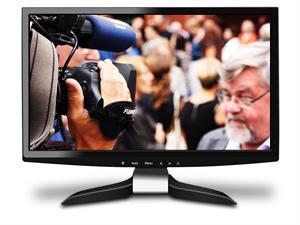PDF chapter test TRY NOW
One of the most common uses of Light Emitting Diodes is LED television.
An LED TV is an LCD (Liquid Crystal Display) television with a LED (Light Emitting Diode) display. An LED display uses Light Emitting Diodes for backlight, and pixels are created by a grid or an array of LEDs.

LED television
Monochrome (black and white) television uses white LEDs, while colour television uses LEDs that emit red, green, and blue (RGB) colours. In 1977, James P. Mitchell created the world's first LED television screen.

Monochrome television
At first, the display was monochrome (one colour). However, in \(2009\), SONY released the first commercial LED television after nearly three decades.
Advantages of LED television:
- LED television has brighter picture quality than LCD television.
- LED television is thinner in size compared to any other television.
- The television uses less power and consumes very little energy.
- LED television has more life span.
- LED television is more reliable than any other television.
Reference:
https://www.maxpixel.net/static/photo/1x/Technology-Monitor-Display-Television-Screen-Tv-1276949.jpg
